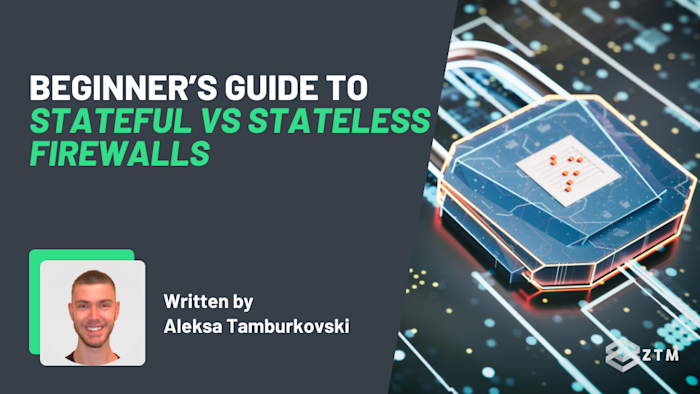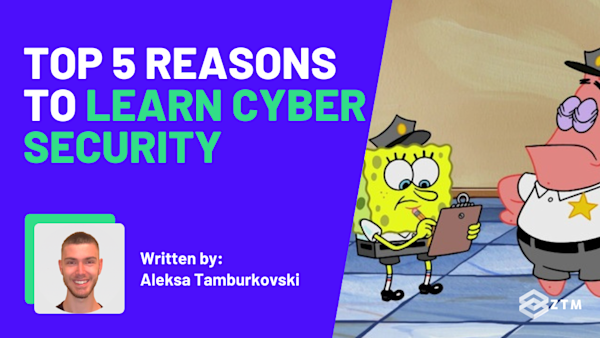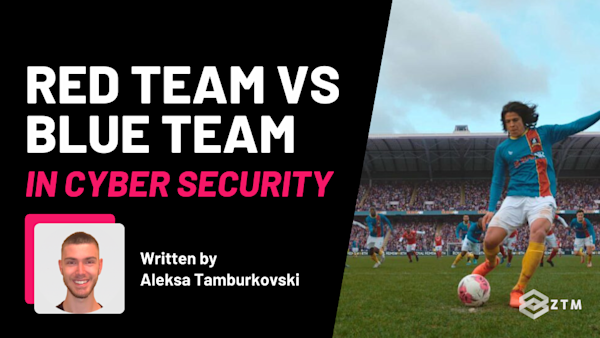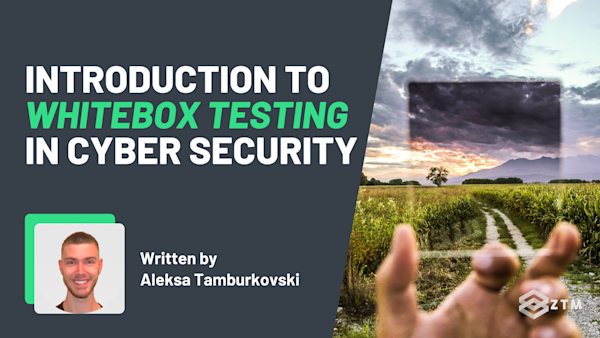It’s easy to assume all firewalls work the same way, in that they block the bad stuff and let the good stuff through. However, the way a firewall makes those decisions can vary a lot, especially if it's either a stateful or stateless firewall.
So what’s the difference and why does it matter?
Don’t worry because in this guide I’ll break down what each type does, how they differ, and when you’d want to use one over the other to keep your network secure.
So let’s dive in…
Sidenote: Firewalls are great but they’re only a small part of a secure system. If you want to learn how to better protect your business then check out my complete Cyber Security Bootcamp!
Updated for 2025, this is the most comprehensive Cyber Security Bootcamp that you can find that’s completely beginner friendly. You’ll not only be able to secure your own systems, but you'll learn enough to be hired as a Cyber Security professional!
With that out of the way, let’s get into this guide.
What do firewalls actually do?
Firewalls are one of the most fundamental tools in cyber security, but despite how common they are, a lot of people only have a vague idea of what they actually do.
At their core, firewalls sit between two parts of a network, (typically between your internal systems and the wider internet), and act as a checkpoint. Their job is to monitor the traffic coming in and going out, and decide whether to allow it to pass through based on a set of rules.
Is the traffic coming from a trusted source?
Is it using the right protocol or port?
Is it part of something we asked for, or from something suspicious?
Firewalls try to answer those questions in real time, making sure your systems aren’t blindly accepting just anything that knocks on the door.
But the way they answer those questions can vary. Some firewalls make decisions using only the details in each individual packet of data. Others take a broader view, keeping track of ongoing conversations between devices to understand the context of each request.
We call these two approaches stateless and stateful, and both have their pros and cons.
So let’s break them down, one at a time.
What is a stateless firewall?
The best way to think of a stateless firewall is like a nightclub bouncer who checks each person’s ID at the door.
Every guest is evaluated on the spot to see if they meet requirements or ‘rules’:
Are they over the right age?
Do they meet the dress code?
If yes, they’re allowed in. If not, they’re turned away.
However, there’s an important nuance to this approach, which is if someone steps outside and tries to come back in, they’re treated like a stranger and rechecked again to make sure they fit those entry requirements.
This is because the bouncer doesn’t have the capacity to remember everyone who was already let in earlier. They just follow the rules in front of them, one person at a time, so that they can work through the queue as fast as possible, while not getting fined for letting underage drinkers in.
This is almost identical to how a stateless firewall handles network traffic.
It looks at each packet in isolation
Checks where it came from
Where it’s going
What port it’s using
And what kind of protocol it’s running
Then it compares that data against a static set of rules. If the packet matches, it’s allowed. If it doesn’t, it’s blocked.
And just like with the bouncer, because stateless firewalls don’t track what’s already happened, they can inspect huge volumes of traffic without slowing down. (As high as millions of packets of data).
This speed makes them ideal in places where performance is critical and the traffic is predictable.
In front of infrastructure services like DNS or DHCP
Inside high-speed routers that need to filter traffic fast
Or as part of a layered setup where other tools handle the deeper analysis
However, it’s only so fast because it has no memory or context of that traffic. And so when you use them, you need to be aware of potential security gaps and user issues.
Stateless user issues
Let’s say that someone inside your network sends a request to a web server. The stateless firewall sees that outbound traffic, checks the rule, and lets it through.
But when the server replies? That response comes back as a new, separate packet. The firewall doesn’t recognize it as part of the same conversation, so unless there’s a second rule allowing that incoming traffic, the reply gets blocked.
So to make normal activities like browsing the web or using an app work smoothly, you have to write two rules for every connection: one for outbound traffic, and one for the return path. Forget one, and things break. Go too broad, and you might accidentally open up access to traffic you didn’t intend to allow.
And then there’s the security side.
Stateless security issues
Because a stateless firewall doesn’t know whether a request was ever made, it can’t confirm if an incoming packet is real or fake.
So if an attacker sends a forged packet that looks like a response or even mimics a reply from a trusted server, then the firewall has no way to verify it. If it fits the rule, it gets through.
For example
If we go back to our nightclub analogy, the security at the main entrances is super rigid. Even people going out and back in are tested.
It seems secure, but what if someone snuck in through a bathroom window? They would be inside and unnoticed because the bouncer at the front assumes everyone inside was already checked.
Heck, what if they just had a really good fake id?
Well, the same thing can happen with a stateless firewall because it only checks only what it sees in front of it. So if traffic enters in a way that fits the rules, it gets let in, even if it shouldn't be there in the first place.
This is why attackers scan for open ports and outdated services before they try more sophisticated hacks, because they’re looking for weaknesses in rule-based setups that don’t check context.
Obviously both of these situations are not great, which is why we also have stateful firewalls.
So let’s break them down.
What is a stateful firewall?
If a stateless firewall is like a bouncer who checks IDs but forgets everyone the moment they walk in, a stateful firewall is more like a restaurant host with a guest list.
Not only do they check who’s at the door but they also keep track of who’s already inside, what time they arrived, and who they came in with. So if someone steps outside for a phone call and comes back, they’re let in right away. The host remembers them and knows they belong.
That’s what a stateful firewall does with traffic. Instead of evaluating each packet on its own:
It remembers the connections that are happening
It keeps a table of active sessions, knowing who started what, where it’s going, what ports are being used
And then uses that memory to make access decisions
For example
Let’s say you open a web browser and visit a site.
Your device then sends a request to the server
The firewall sees that outgoing connection, and marks the session as active
When the server replies, the firewall recognizes the incoming traffic as part of the same conversation and lets it through, even if there isn’t a specific rule allowing inbound traffic from that server, because it remembers you started the exchange
This context-aware behavior is what makes stateful firewalls so common. In fact, if you’re using a home router, a laptop with built-in firewall settings, or even a basic cloud setup, you’re almost certainly using a stateful firewall built in.
The main benefit of stateful is that they don’t have to write two separate rules for every connection. You don’t have to guess whether traffic is a reply or a random packet. The firewall figures that out for you. That makes it great for dynamic environments where users are constantly opening apps, browsing sites, and connecting to services.
However, they also have issues
Stateful firewall security issues
Because they trust anything that looks like part of an existing session, they can be exploited if something bad gets in first.
For example
If a hacker gains access to a device inside the network and then tries to connect to a command-and-control server, the firewall will likely allow the outbound request.
The issue from here is that the firewall will treat any incoming traffic on that session as legitimate — even if it’s an attacker sending instructions or downloading more tools.
Why?
Because the connection started from the inside, and the firewall remembers that, so it assumes the traffic is part of something you intended.
Not great right?
This is why firewalls are always just a part of a more secure process. You need systems in place to check traffic for unusual logins, transfers, etc.
The other tradeoff when using stateful firewalls is performance.
Stateful performance issues
Because stateful firewalls are keeping track of every active session, it uses more memory and processing power than a stateless one. On a small network, that’s no big deal. But on large systems or high-speed environments, it can become a bottleneck, especially if the firewall is doing other things like deep inspection or logging.
So what's the solution here?
Well the trick is to actually use a combination of firewalls…
What is a next-generation firewall (NGFW)?
If stateless firewalls are rule-following bouncers, and stateful firewalls are attentive hosts with guest lists, then a next-generation firewall is more like a security manager who does it all. They don’t just check IDs and remember who’s inside. They also watch for suspicious behavior, track who people are with, scan their bags, and even know who’s on a watchlist.
Sounds good right, but how do they do this?
Next-generation firewalls (NGFW) combine the strengths of both stateless and stateful firewalls, and further then layers onto that with a deeper level of awareness so that it can detect and block known threats, all in real time.
This includes:
Deep packet inspection (DPI): Instead of just looking at headers, NGFWs analyze the full packet, including payloads. That means they can detect malware, encrypted threats, or policy violations that traditional firewalls would miss
Application awareness: They don’t just see “traffic on port 443”. They also see “this is Zoom,” or “this is Dropbox.” That makes it easier to control how specific apps are used, regardless of port or protocol
User-based control: NGFWs can integrate with identity systems, so rules can be written based on who a user is and not just what their IP address is
Built-in intrusion prevention: Many NGFWs include signature-based threat detection, which helps spot known attacks like SQL injection or port scanning
Next Gen firewalls are commonly used in enterprise networks, cloud platforms, and anywhere that visibility and control are critical.
They are ideal when you need visibility into what’s really happening on the network., or if your security concerns go beyond “block this IP” and into “control how data flows and catch threats in real time”.
However, that extra security comes with tradeoffs too.
NGFWs require more processing power and memory. They’re more complex to manage. And because they do so much, misconfigurations can introduce just as many problems as they solve if they’re not carefully tuned.
They’re not overkill, but they’re not plug-and-play either. They’re designed to sit at the heart of a broader, layered security strategy.
Mile high comparison
So as a quick recap:
Stateless firewalls are fast, lightweight, and perfect for predictable traffic, especially at the edge of a network where performance matters most. But they need careful rule management and can’t track ongoing sessions.
Stateful firewalls bring more flexibility by remembering what connections are active and allowing return traffic automatically. That makes them a great fit for day-to-day use, from home setups to corporate networks.
While Next-generation firewalls go a step further. They combine everything stateful firewalls can do, then add deep packet inspection, app awareness, user tracking, and threat prevention, all in real time. They’re ideal for complex environments where visibility and control matter just as much as performance.
To make it easier for you to remember, I’ve laid out the main differences below:
Feature | Stateless firewall | Stateful firewall | Next-generation firewall (NGFW) |
Traffic awareness | Looks at individual packets only | Tracks ongoing connections (sessions) | Tracks sessions and inspects packet contents |
Memory of past traffic | None | Yes – remembers active connections | Yes – plus deeper context like users, apps, threats |
Speed and performance | Very fast, minimal processing | Slower than stateless, due to session tracking | Heaviest – requires more resources for analysis |
Security depth | Basic filtering (IP, port, protocol) | Context-aware, but limited to session rules | High – can detect threats, malware, misuse, etc. |
Rule complexity | Requires rules for each direction | Simpler rules – allows return traffic automatically | More complex policies, but more flexible |
Threat detection | None | None | Yes – built-in threat detection and prevention |
Application control | No | No | Yes – can identify and control specific applications |
Best for | Predictable, high-speed traffic | General-purpose user networks | Enterprise, cloud, and high-security environments |
Common examples | Routers, DNS/DHCP filters, AWS NACLs | Home routers, cloud firewalls, pfSense | Palo Alto, Fortinet, Cisco Firepower, Check Point |
So which should you use?
The reality is you don’t always have to pick just one. In fact, many real-world networks use a mix.
But if you’re trying to choose the right place to start, here’s a practical breakdown:
If performance is your top concern, and you’re working with simple, predictable traffic like DNS, DHCP, or VoIP, then you should use a stateless firewall. These are common in setups like AWS NACLs or edge routers. They’re fast and lightweight but need tight, manual rules
If you’re running a small-to-medium business, or just trying to protect a home office or startup, go with a stateful firewall. These are usually built right into your modem or router (like a home or office gateway from Netgear, Asus, or even cloud platforms like pfSense or Ubiquiti). They track connections and handle return traffic automatically, so no extra setup needed in many cases. Usually just tweaking settings and making sure passwords are not set to admin!
If you’re managing a larger company, dealing with sensitive data, remote teams, or compliance requirements, you’ll want a next-generation firewall (NGFW). These come from vendors like Palo Alto, Fortinet, and Cisco, and can be installed virtually or as hardware.
It's not about picking the “best” firewall, but choosing the right mix for how your network actually works.
P.S.
Just a heads up but if you decide to join Zero To Mastery as a member, you get access to ALL of my cybersecurity courses and more.

Every tech course on the platform is available, as well as access to our private Discord server.
Here you can chat to me, other students, and working cyber security professionals and get help with any questions you might have 24/7.
It’s the best investment you can make to improve your Cyber Security in 2025.
Best articles. Best resources. Only for ZTM subscribers.
If you enjoyed Aleksa's post and want to get more like it in the future, subscribe below. By joining over 500,000 ZTM email subscribers, you'll receive exclusive ZTM posts, opportunities, and offers.
No spam ever, unsubscribe anytime







